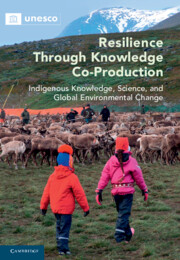 Resilience through Knowledge Co-Production
Resilience through Knowledge Co-Production Book contents
- Resilience through Knowledge Co-production
- Resilience through Knowledge Co-production
- Copyright page
- Contents
- Contributors
- Acknowledgements
- Introduction
- Part I From Practice to Principles
- 2 The Progression from Collaboration to Co-production: Case Studies from Alaska
- 3 Learning about Sea Ice from the Kifikmiut: A Decade of Ice Seasons at Wales, Alaska, 2006-2016
- 4 Shaping the Long View: Iñupiat Experts and Scientists Share Ocean Knowledge on Alaska’s North Slope
- 5 Indigenous Ice Dictionaries: Sharing Knowledge for a Changing World
- 6 Mapping Land Use with Sámi Reindeer Herders: Co-production in an Era of Climate Change
- 7 Sámi Herders’ Knowledge and Forestry: Ecological Restoration of Reindeer Lichen Pastures in Northern Sweden
- Part II Indigenous Perspectives on Environmental Change
- Part III Global Change and Indigenous Responses
- Epilogue
- Index
- References
7 - Sámi Herders’ Knowledge and Forestry: Ecological Restoration of Reindeer Lichen Pastures in Northern Sweden
from Part I - From Practice to Principles
Published online by Cambridge University Press: 02 June 2022
- Resilience through Knowledge Co-production
- Resilience through Knowledge Co-production
- Copyright page
- Contents
- Contributors
- Acknowledgements
- Introduction
- Part I From Practice to Principles
- 2 The Progression from Collaboration to Co-production: Case Studies from Alaska
- 3 Learning about Sea Ice from the Kifikmiut: A Decade of Ice Seasons at Wales, Alaska, 2006-2016
- 4 Shaping the Long View: Iñupiat Experts and Scientists Share Ocean Knowledge on Alaska’s North Slope
- 5 Indigenous Ice Dictionaries: Sharing Knowledge for a Changing World
- 6 Mapping Land Use with Sámi Reindeer Herders: Co-production in an Era of Climate Change
- 7 Sámi Herders’ Knowledge and Forestry: Ecological Restoration of Reindeer Lichen Pastures in Northern Sweden
- Part II Indigenous Perspectives on Environmental Change
- Part III Global Change and Indigenous Responses
- Epilogue
- Index
- References
Summary
The research on the ecological restoration of reindeer lichen pastures described in this chapter relates the dynamic and complex endeavour of different actors through the coproduction of knowledge. First initiated by forest managers and forest ecologists, it soon became transdisciplinary when Sami reindeer herders collaborated, combining science and Indigenous knowledge to solve a problem in which neither were sufficient by themselves. However, the complex challenge of restoring reindeer lichen pastures in productive forest lands required an interdisciplinary and intersubjective understanding of the various partners’ worldviews and knowledge. This was materialized by fostering a collaborative learning process through experimentation, i.e., controlled field experiments that were jointly designed, established and surveyed. The results of these experiments and experiences enabled the exploration of innovative pathways for ecological restoration and to refine and share common goals.
Keywords
- Type
- Chapter
- Information
- Resilience through Knowledge Co-ProductionIndigenous Knowledge, Science, and Global Environmental Change, pp. 143 - 162Publisher: Cambridge University PressPrint publication year: 2022


